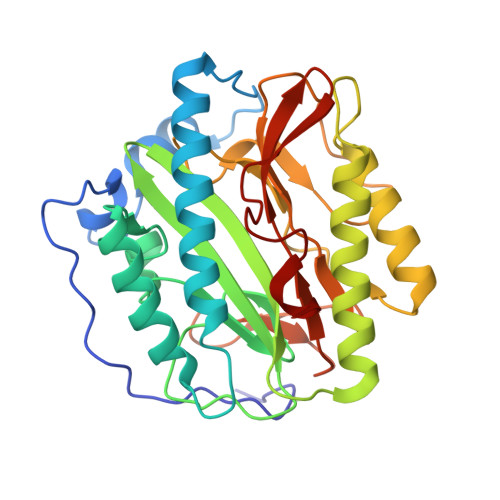Discovery of natural product ovalicin sensitive type 1 methionine aminopeptidases: molecular and structural basis.
Pillalamarri, V., Arya, T., Haque, N., Bala, S.C., Marapaka, A.K., Addlagatta, A.(2019) Biochem J 476: 991-1003
- PubMed: 30837307
- DOI: https://doi.org/10.1042/BCJ20180874
- Primary Citation of Related Structures:
5YKP, 5YR4, 5YR5, 5YR6 - PubMed Abstract:
Natural product ovalicin and its synthetic derivative TNP-470 have been extensively studied for their antiangiogenic property, and the later reached phase 3 clinical trials. They covalently modify the conserved histidine in Type 2 methionine aminopeptidases (MetAPs) at nanomolar concentrations. Even though a similar mechanism is possible in Type 1 human MetAP, it is inhibited only at millimolar concentration. In this study, we have discovered two Type 1 wild-type MetAPs ( Streptococcus pneumoniae and Enterococcus faecalis ) that are inhibited at low micromolar to nanomolar concentrations and established the molecular mechanism. F309 in the active site of Type 1 human MetAP ( Hs MetAP1b) seems to be the key to the resistance, while newly identified ovalicin sensitive Type 1 MetAPs have a methionine or isoleucine at this position. Type 2 human MetAP ( Hs MetAP2) also has isoleucine (I338) in the analogous position. Ovalicin inhibited F309M and F309I mutants of human MetAP1b at low micromolar concentration. Molecular dynamics simulations suggest that ovalicin is not stably placed in the active site of wild-type MetAP1b before the covalent modification. In the case of F309M mutant and human Type 2 MetAP, molecule spends more time in the active site providing time for covalent modification.
Organizational Affiliation:
Department of Applied Biology, CSIR-Indian Institute of Chemical Technology, Hyderabad 500007, Telangana, India.

















